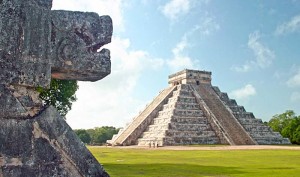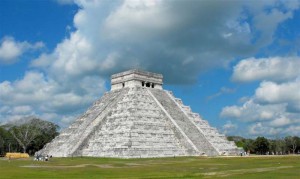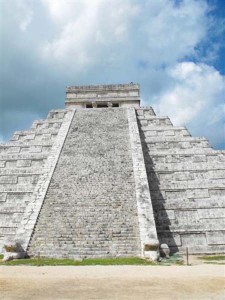
Chichen Itza El Castillo
Chichen Itza El Castillo, known as “The Castle” or “The Pyramid of Kukulcán” the monumental structure dominates the Northern Platform. Dedicated to the serpent God Kukulcán it is also known by its Toltec name the “Pyramid of Quetzalcoatl”.
Kukulcán is a feathered serpent deity closely related to the Aztec God Quetzalcoatl. The God Kukulcán was both a war serpent and a vision serpent and is closely associated with noble figures. In Chichén Itza, he presides over sacrifices.
The Kukulcán cult was centered in Chichén Itza in the Classic Period (200 CE–1000CE) and was adopted by other cultures and linguistic groups as far away as the highlands of Guatemala. This adoption of a common God facilitated trade and comm
unication between cultures and social backgrounds.
El Castillo is a Mesoamerican stepped Pyramid approximately 30 meters (98 feet) high; the base is 55.3 meters (181 feet) square. It was built by the Mayans from the 9th to 12th century AD. There is archeological evidence that this pyramid was built atop at least on other. In the 1930’s scientists discovered another temple containing a Chac Mool and a Jaguar throne. The jaguar is painted red and has inlaid jade spots.

El Castillo is a magnificent tribute to the mathematical and astronomical skills of the Maya. The accuracy of the celestial measurements combined with their rich religious beliefs to produce this outstanding temple full of intrigue, mystery and sheer wonder.
Each side of the four sides of the pyramid has 91 stairs or a total of 364. The common platform at the top makes the grand total of 365 stairs – the number of days in a year. The Pyramid is layered like a cake with nine tiers. The staircase divides the tiers creating 18 tiers per side. The Mayan calendar had 18 months (winals) to form a Mayan year (tun).
There are 52 rectangular panels on each side of the pyramid. This corresponds to convergence year of the Mayan’s solar calendar and their ritual calendar which happens once every 52 years. Some archeologists believe that the Mayans built or rebuilt monuments every 52 years.
The Northern face of the pyramid face the platform of Venus and the Sacred Cenote. This staircase has huge serpents’ heads representing the God Kukulcán. Every year thousands of visitors gather at Chichén Itza in the late afternoon during the spring and fall equinox (March 21 and September 21) to witness the illusion of the snake slithering down the pyramid. The illusion is created by the low sun casting a shadow over the northern Balustrade and the illumination of the serpent’s head at the bottom at the base of the temple.

El Castillo is a magnificent tribute to the mathematical and astronomical skills of the Maya. The accuracy of the celestial measurements combined with their rich religious beliefs to produce this outstanding temple full of intrigue, mystery and sheer wonder.
The Government body that manages antiquities National Institute of Anthropology and History
(INAH) has gradually been closing off the monuments in Chichén Itza and unfortunately since 2006 the El Castillo can no longer be climbed and access to the throne room and temple on the top is restricted.